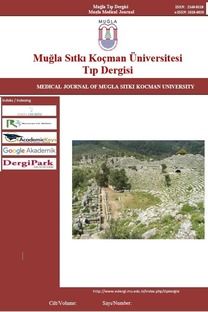Covid-19 Pandemisinde Apandisitler Daha Komplike Miydi?
Covid-19, akut apandisit, morbidite, komplike apandisit
Were appendicitis’ more complicated in the Covid-19 pandemic?
Covid-19, acute appendicitis, morbidity, complicated appendicitis,
___
- 1. De Simone B, Chouillard E, Di Saverio S, et al. Emergency surgery during the COVID-19 pandemic: what you need to know for practice. Ann R Coll Surg Engl. 2020;102(5):323-32.
- 2. Coronavirus disease (COVID-19) Situation Report – 192 Available from: https://www.who.int/docs/default-source/coronaviruse/situation-reports/20200730-covid-19-sitrep-192.pdf?sfvrsn=5e52901f_4.
- 3. Cervellin G, Mora R, Ticinesi A, et al. Epidemiology and outcomes of acute abdominal pain in a large urban Emergency Department: retrospective analysis of 5,340 cases. Ann Transl Med. 2016;4(19):362.
- 4. Tankel J, Keinan A, Blich O, et al. The Decreasing Incidence of Acute Appendicitis During COVID-19: A Retrospective Multi-centre Study. World J Surg. 2020;44(8):2458-63.
- 5. What to Do If You Are Sick. Available from: https://www.cdc.gov/coronavirus/2019-ncov/if-you-are-sick/steps-when-sick.html.
- 6. Snapiri O, Rosenberg C, Krause I, et al. Delayed diagnosis of paediatric appendicitis during the COVID-19 pandemic. Acta Paediatr. 2020;109(8):1672-6.
- 7. Andersso, RE, Petzold MG. Nonsurgical treatment of appendiceal abscess or phlegmon: a systematic review and meta-analysis. Ann Surg. 2007;246(5):741-8.
- 8. Masroor S. Collateral damage of COVID-19 pandemic: Delayed medical care. J Card Surg. 2020;35(6):1345-7.
- 9. Patients with heart attacks, strokes and even appendicitis vanish from hospitals. Available from: https://www.washingtonpost.com/health/patients-with-heart-attacks-strokes-and-even-appendicitis-vanish-from-hospitals/2020/04/19/9ca3ef24-7eb4-11ea-9040-68981f488eed_story.html.
- 10. Metzler B, Siostrzonek P, Binder KR, et al. Decline of acute coronary syndrome admissions in Austria since the outbreak of COVID-19: the pandemic response causes cardiac collateral damage. Eur Heart J. 2020;41(19):1852-3.
- 11. Garcia S, Albaghdadi Mazen S, Meraj P, et al. Reduction in ST-Segment Elevation Cardiac Catheterization Laboratory Activations in the United States During COVID-19 Pandemic. J Am Coll Cardiol. 2020;75(22):2871-2.
- 12. Romero J, Valencia S, Guerrero A. Acute Appendicitis During Coronavirus Disease 2019 (COVID-19): Changes in Clinical Presentation and CT Findings. J Am Coll Radiol. 2020;17(8):1011-3.
- 13. Zheng MH, Boni L, Fingerhut A. Minimally Invasive Surgery and the Novel Coronavirus Outbreak: Lessons Learned in China and Italy. Ann Surg. 2020;272(1):5-6.
- ISSN: 2148-8118
- Yayın Aralığı: Yılda 3 Sayı
- Başlangıç: 2014
- Yayıncı: Muğla Sıtkı Koçman Üniversitesi
Eozinofilik Püstüler Dermatoz: 50 Yılın Ardından
Ceyda TETİK AYDOĞDU, Suzan DEMİR PEKTAŞ
Seyhan HIDIROĞLU, Şükran PEKER, Melda KARAVUŞ, Pınar TEPE, Seyfullah AKÇABEY, Ali Ömer KAYA, Hakan ÖZTÜRKÇÜ, Nimet Emel LÜLECİ, Dilşad SAVE
Tuğrul ERGÜN, Çiğdem OBUZ TOPUZ
Zeynep Anıl ŞAHİN, İsmail Gökhan ŞAHİN, Leyla BOZATLI, Işık GÖRKER
Multiple Sklerozda Periferik Sinir Sistemi Tutulumunun Araştırılması
Ezgi Işıl TURHAN, Melike NALBANT, Mehmet BAYRAK
Pediatrik Maksillofasiyal Travma: 2015-2020 Yılları Arasında Epidemiyolojik Çalışma
Emine ÖZDEMİR KAÇER, İlker KAÇER, Ahmet ÇAĞLAR
Emrah KILIÇASLAN, Selim SAYIN, Murat YILDIRIM, Tayfun ELİBOL, Hilmi GÖZDEN, Meltem AYLI, Muhammet KAPTAN
Ciddi Akut Böbrek Hasarı Gelişen Multiple Skleroz Olgusu
Burcu ÇİLEK BALİMRE, Ceren ERDOĞAN EROĞLU, Erkan ŞENGÜL, Zahide YILMAZ GÜNEŞ, Didem YILDIZ TOKSÖZ
